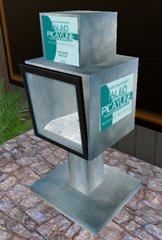by Jeremy Kemp
...not sin (porn, gambling etc.)
...not accessibility (tech reqs, tools for the disabled, complex interface)
...not disruptive strangers (griefers, unaffiliated interlopers, etc.)
...not commercialism and corporatization
...not legal issues with Intellectual Property and the legally questionable Terms of Service
But the MOST troubling feature of this setting for education is the lack of affordances for reflective learning and asynchronous tools in support of learning communities.
Many class sessions in SL seem to wander into the realm of decorative chat.
But the vast majority of online learning at the post secondary level is NOT synchronous. Here at our university, only a small percentage of faculty add a chatroom tool to their LMS designs.
Students who flock to distance learning for flexibility and time-shifting are loathe to set aside a specific time for meetings - especially nano-band activities like instant messaging. I just can't imagine spending ALL my students' time in SL parking their avatars an nyawning through excruciatingly slow chat interactions.
Blending RL synchronous meetings and online asynchronous reflective activities such as threaded messaging and project work seems to be the most successful model. I've used the "book ends" approach in my elearning classes from 2002 on. Students meet for a longish in-person session on campus, arrange teams. This also allows for in-person pre and post assessments and also public speaking training at the final session. Students get the face-to-face benefits but are able to spend less time on campus tied down to a schedule. Each mode has its strengths and their work is tightly integrated RL/online.
So virtual environments for learning represent a two-legged stool when used by themselves. We benefit from an engaging feeling of presence and also from the visualization and modeling. But the missing third leg of the stool is reflectivity. The platform is woefully lacking ways to integrate in-world learning with existing distance learning tools for reflection such as threaded messaging, blogs, portfolios, assignment structures and assessments.
In my own class work, I'm struggling to create a multi-modal experience where my students may choose how they devote time to the class. Grading is a pain: How do you assign grades for a team when 1/2 of the members want to meet in-world to give chat presentations while the others cannot commit to meeting times and prefer building on their own and leaving items for the others to work with?
Does anyone have advice for instructional design in a multi-modal setting like this? For connecting your previous LMS instructional designs with this new synchronous-centric tool?
Ideas?
Jeremy Kemp, M.Ed., M.S.J.
Assistant Director, SL Campus
School of Library & Information Science
San Jose State University
SL: Jeremy Kabumpo
Subscribe to:
Post Comments (Atom)


2 comments:
Well said. SL is designed for synchronous interaction. While it's very possible to make asynchronous use of it, other existing tools would probably be much more efficient for that. I don't have any direct suggestions for you (other than use SL where it offers a distinct advantage, and use other tools where they more helpful), but I do appreciate what you say--it is something we all need to keep in mind.
One thought about the group projects--could the presentation be prerecorded (students in the group each work on parts and group edit with appropriate asynchronous tools), and then be available for viewing in SL as a media file with accompanying documents/links?
Tim Thompson
(Joskie Despres SL)
I agree that SL is not a 1-for-1 replacement of other learning environments; rather, it's another tool in the toolbox. I personally believe it's best use is when you have a need for an exploratory environment coupled with the need for social interaction. So use SL for the parts of your curriculum that benefit from these things. Don't shoehorn activities into the environment just to have all in one place.
I've been in charge of training and support for Penn State's CMS, ANGEL, for six years now, and I understand exactly where your frustrations are coming from. At PSU, the chat tool is the least used tool in the CMS. After six years, faculty are just now beginning to grasp the unique possibilities of online activities and where the balance between F2F and online needs to be. Can we hope for a shorter learning time in virtual worlds? Dunno.
As for team activities, that are many things you can try. Have the team members write a MoU prior to a major team activity. The MoU should include rules of conduct for all, and options for kicking someone off the team if they don't abide by those rules. Have the teams cross grade one another. Have the team do a joint presentation at the end of the activity where every team member must talk about their part of the process.
Post a Comment